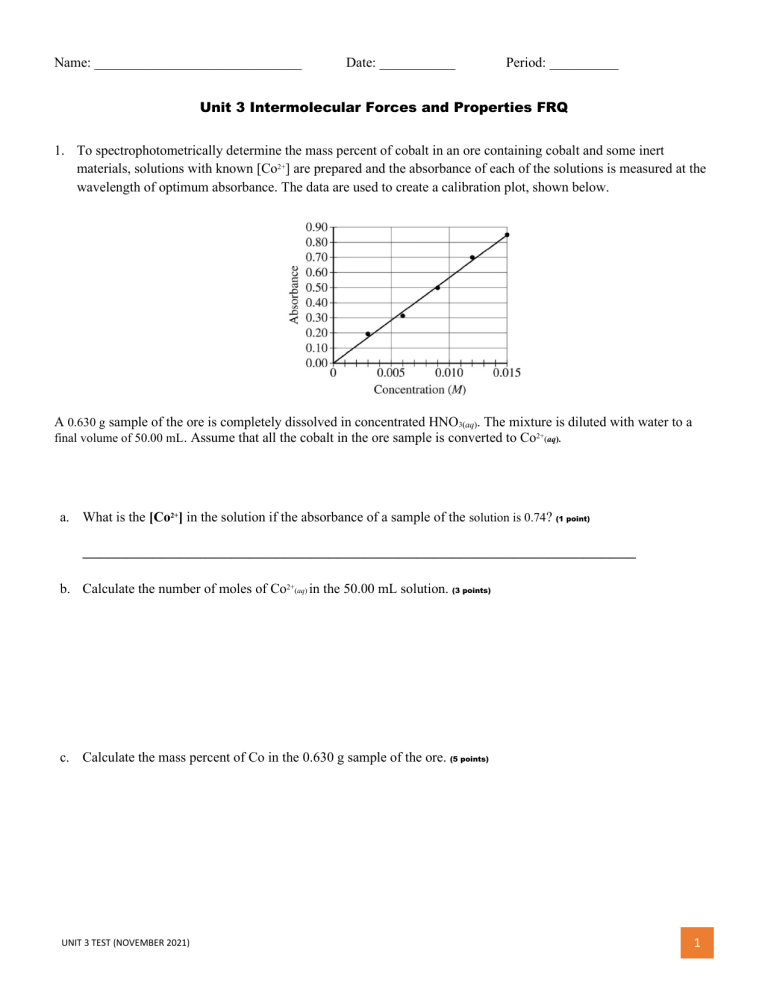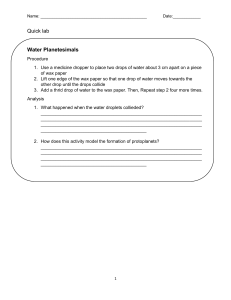
Name: ______________________________ Date: ___________ Period: __________ Unit 3 Intermolecular Forces and Properties FRQ 1. To spectrophotometrically determine the mass percent of cobalt in an ore containing cobalt and some inert materials, solutions with known [Co2+] are prepared and the absorbance of each of the solutions is measured at the wavelength of optimum absorbance. The data are used to create a calibration plot, shown below. A 0.630 g sample of the ore is completely dissolved in concentrated HNO3(aq). The mixture is diluted with water to a final volume of 50.00 mL. Assume that all the cobalt in the ore sample is converted to Co2+(aq). a. What is the [Co2+] in the solution if the absorbance of a sample of the solution is 0.74? (1 point) _______________________________________________________________ b. Calculate the number of moles of Co2+(aq) in the 50.00 mL solution. (3 points) c. Calculate the mass percent of Co in the 0.630 g sample of the ore. (5 points) UNIT 3 TEST (NOVEMBER 2021) 1 2. A student has 100. mL of 0.400 M CuSO4(aq) and is asked to make 100. mL of 0.150 M CuSO4(aq) for a spectrophotometry experiment. The following laboratory equipment is available for preparing the solution: centigram balance, weighing paper, funnel, 10 mL beaker, 150 mL beaker, 50 mL graduated cylinder, 100 mL volumetric flask, 50 mL buret, and distilled water. a. Calculate the volume of 0.400 M CuSO4(aq) required for the preparation. (5 points) b. Briefly describe the essential steps to most accurately prepare the 0.150 M CuSO4(aq) from the 0.400 M CuSO4(aq) using the equipment listed above. (2 points) ___________________________________________________________________________________________ ___________________________________________________________________________________________ ___________________________________________________________________________________________ ___________________________________________________________________________________________ ___________________________________________________________________________________________ ___________________________________________________________________________________________ ___________________________________________________________________________________________ ___________________________________________________________________________________________ The student plans to conduct a spectrophotometric analysis to determine the concentration of Cu2+(aq) in a solution. The solution has a small amount of Co(NO3)2(aq) present as a contaminant. The student is given the diagram below, which shows the absorbance curves for aqueous solutions of Co2+(aq) and Cu2+ (aq). c. The spectrophotometer available to the student has a wavelength range of 400 nm to 700 nm. What wavelength should the student use to minimize the interference from the presence of the Co2+ (aq) ions? (1 point) ___________________________________________________________________________________________________________________________________________ UNIT 3 TEST (NOVEMBER 2021) 2 3. Answer the following questions in terms of principles of chemical bonding and intermolecular forces. In each explanation where a comparison is to be made, a complete answer must include a discussion of both substances. The following complete Lewis electron-dot diagrams may be useful in answering parts of this question. a. At 1 atm and 298 K, pentane is a liquid whereas propane is a gas. Explain. (3 points) _________________________________________________________________________________________ _________________________________________________________________________________________ _________________________________________________________________________________________ _________________________________________________________________________________________ _________________________________________________________________________________________ _________________________________________________________________________________________ _________________________________________________________________________________________ _________________________________________________________________________________________ _________________________________________________________________________________________ b. At 1 atm and 298 K, methanol is a liquid whereas propane is a gas. Explain. (3 points) _________________________________________________________________________________________ _________________________________________________________________________________________ _________________________________________________________________________________________ _________________________________________________________________________________________ _________________________________________________________________________________________ _________________________________________________________________________________________ _________________________________________________________________________________________ _________________________________________________________________________________________ _________________________________________________________________________________________ UNIT 3 TEST (NOVEMBER 2021) 3 c. Indicate the hybridization of the carbon atom in each of the following: (2 points) i. Methanol _____________ ii. Methanoic (formic) acid d. ______________ Draw the complete Lewis electron-dot diagram for a molecule of propanoic acid, HC3H5O (1 point) e. Explain the following observations about the two carbon-oxygen bonds in the methanoate (formate) anion, HCO2−. You may draw a Lewis electron-dot diagram (or diagrams) of the methanoate ion as part of your explanations. i. The two carbon-oxygen bonds in the methanoate (formate) anion, HCO2−, have the same length. (2 points) __________________________________________________________________________________ __________________________________________________________________________________ __________________________________________________________________________________ __________________________________________________________________________________ __________________________________________________________________________________ __________________________________________________________________________________ ii. The length of the carbon-oxygen bonds in the methanoate (formate) anion, HCO2−, is intermediate between the length of the carbon-oxygen bond in methanol and the length of the carbon-oxygen bond in methanal. (2 points) __________________________________________________________________________________ __________________________________________________________________________________ __________________________________________________________________________________ __________________________________________________________________________________ __________________________________________________________________________________ UNIT 3 TEST (NOVEMBER 2021) 4 4. Some building materials contain small capsules filled with paraffin wax to improve the insulating properties of the materials. The melting and freezing of paraffin inside the capsules in the material helps to regulate temperature. Paraffin wax begins to melt at 37oC. a. While the wax is melting, is the net flow of thermal energy (heat) from the wax to the surroundings or from the surroundings to the wax? Justify your answer in terms of endothermic and exothermic process (2 points) ____________________________________________________________________________________ ____________________________________________________________________________________ ____________________________________________________________________________________ ____________________________________________________________________________________ ____________________________________________________________________________________ ____________________________________________________________________________________ ____________________________________________________________________________________ b. Calculate the amount of thermal energy, in KJ , that is required to melt 15.2 grams of solid paraffin wax when the temperature of the surroundings is above the melting point of paraffin. (The molar mass of paraffin is 282.62 g/mol and its molar heat of fusion is 48.78 kJ/mol.) (5 points) c. When paraffin wax melts, its density decreases. Provide a particle-level explanation of this observation. (2 points) _____________________________________________________________________________________ _____________________________________________________________________________________ _____________________________________________________________________________________ _____________________________________________________________________________________ _____________________________________________________________________________________ _____________________________________________________________________________________ ____________________________________________________________________________________ UNIT 3 TEST (NOVEMBER 2021) 5 5. In the space below tell me about all the things that you learned that I did not ask on the test. ____________________________________________________________________________________________ ____________________________________________________________________________________________ ____________________________________________________________________________________________ ____________________________________________________________________________________________ ____________________________________________________________________________________________ ____________________________________________________________________________________________ ____________________________________________________________________________________________ ____________________________________________________________________________________________ ____________________________________________________________________________________________ ____________________________________________________________________________________________ ____________________________________________________________________________________________ ____________________________________________________________________________________________ ____________________________________________________________________________________________ ____________________________________________________________________________________________ ____________________________________________________________________________________________ ____________________________________________________________________________________________ ____________________________________________________________________________________________ ____________________________________________________________________________________________ ____________________________________________________________________________________________ ____________________________________________________________________________________________ ____________________________________________________________________________________________ ____________________________________________________________________________________________ ____________________________________________________________________________________________ ____________________________________________________________________________________________ ____________________________________________________________________________________________ ____________________________________________________________________________________________ ____________________________________________________________________________________________ UNIT 3 TEST (NOVEMBER 2021) 6





